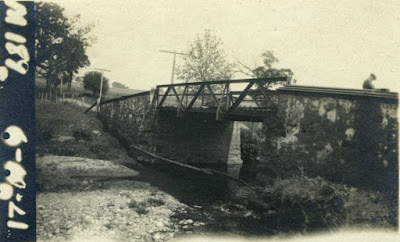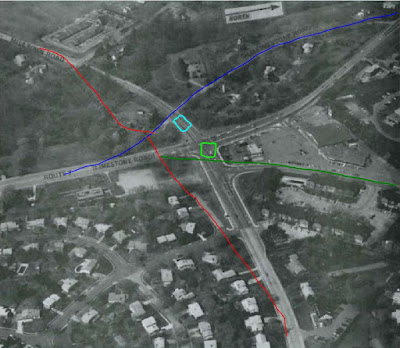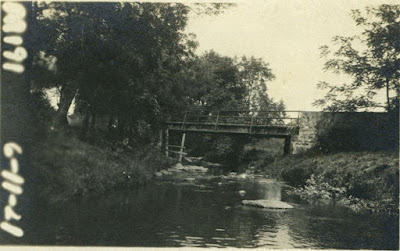 |
| A bridge on Milltown Road, 1921 |
To be honest, this is one of those topics I had neatly avoided for years, primarily because it always seemed like more trouble than it was worth. I kind of understood what had happened, but it never completely made sense to me. Recently, however, with the help of Bob Wilhelm (who grew up very near the intersection), it all now seems much more clear. Hopefully it will to you, too, when you're done reading the post. It draws heavily upon Bob's recollections of his youth, and I thank him greatly for his help.
 |
| Milltown in 1893 |
As with any good story, I suppose we should start at the very beginning. (A singing nun once told me it's a very good place to start.) In this case, the beginning would be the state of the intersection in the early days of the 20th Century. The best representation we have of that is the 1893 map shown above. As you can see, while it might seem the same at first glance, there are several notable differences between the road layout then and what it is today. First, Limestone Road (heading north) makes a bend to the left right in front of the Chandler property, and runs close to Mill Creek for a stretch, before making a sharp left to cross it.
Second, Milltown Road runs between the Abram Chandler House and the Harlan Mill. It also seems to be two separate roads east and west of Limestone, meeting it at different places. In fact, Milltown at the time was described as being the place where five roads met. Lastly and least obviously, the southern end of McKennans Church Road is straighter than it is today. What's not visible on the map are the changes to the topography of the area. All these changes were done at different times, but there are still very evident traces of the old configuration to be found, if you know where to look.
 |
| Plans for 1922 work on Limestone Road |
 |
| Limestone Road over Mill Creek, 1921 |
 |
| "New" Limestone Road bridge, c.1923 |
What I find really interesting and useful about this diagram is how it helps to orient another image that I had seen before, but hadn't fully understood. The photograph at the top of the page comes from the 1921 Bridge Survey mentioned in the previous post. Bridges throughout New Castle County were documented and photographed, presumably to determine if they were still viable in the rapidly expanding Automobile Age. The photographer is standing just below the mill pond looking almost directly towards the top of the diagram. The small bridge is carrying Milltown Road over the mill race on the property owned at that time by Pusey Pennock.
If you look closely, on the far left you can see one of the Chandler House's fancy metal porch posts. More interestingly, though, in the upper right you can see part of the John Ball House -- the "Stone House" on the diagram. This is the house in which Lewis Heisler Ball grew up, and which was later owned by Marvin Klair. As of now, this is the only photographic evidence I've seen of this house. Until seeing the 1922 diagram, I had no idea what that house was.
After the 1922 improvements, the roads in the area stayed more or less the same for nearly four decades. Then, in the late 1950's, changes began to come to the Milltown area. Numerous housing developments started to go up, and John Dickinson High School opened in 1959. The narrow roads, old bridges, and broken-up layout that worked fine for rural traffic was no longer adequate for the increased suburban vehicle flow. Things needed to updated, and they soon were.
The first of the two major projects took place in 1960, and focused on Milltown Road. This was the work that claimed the Ward-Dudkewitz House, as the road was rerouted directly through where the house had stood. Milltown Road was widened and paved its entire length (the last post shows before and after shots of the Newport Gap Pike end), and a section several hundred feet on either side of Limestone Road was moved slightly northward, allowing for a continuous road and a by-passing of the Harlan-Chandler Complex. The photograph below shows the paths of the old roads and the new, as well as the approximate locations of the Ward-Dudkewitz House and the Ball-Klair House. (Note that it's oriented looking west along Milltown Road)
 |
| Showing old paths of Milltown Rd (red), Limestone Rd (blue), McKennans Church Rd (green); approx. locations of houses, Ward-Dudkewitz (green) and Ball-Klair (teal) |
 |
| Old Milltown Road bridge over Mill Creek, 1921 |
It's possible that it was always planned as two parts of one big project, but two years after the Milltown Road work, the state was back, this time to tackle Limestone Road. Again, the plan was to widen the road as well as to reroute a section of it to bypass the old area of Milltown. Also again, a new bridge would be needed. As you could see in the photo of the 1922 bridge earlier, it was just nowhere near sturdy enough for the rapidly increasing motor traffic. I believe the new bridge was built right about, if not directly over, the old bridge.
As you can see, with the substantial pieces of the old roads still in place (once you know where to look) it's not too hard to get a feel for what the old layout was like -- at least in two dimensions. The final part of the story is, for me at least, the most difficult to envision. If you've ever been through this area, you know that the Harlan-Chandler Complex and Old Milltown Road are substantially lower in elevation as compared to Limestone Road. You've also, no doubt, noticed the steep hillside behind the shopping center with Walgreens, Total Wine, Dunkin Donuts, etc. (or Acme, if your memory goes back a ways). These features are remnants of the original topography, which was quite a bit hillier than it is now.
Here is where we're fortunate to have the recollections of Bob Wilhelm, who grew up around and walked these roads during the timeframe of the changes. He recalls coming out of his grandparents' driveway (the Ward-Dudkewitz House) onto McKennans Church Road, then turning left down a fairly steep hill to Milltown Road. You then went down another steep incline to get down to Limestone Road. This was, of course, prior to any of the 1960's roadwork.
After the rerouting of Milltown Road, Bob says that as you went west on Milltown down to the intersection with old Limestone Road, there were high banks on either side. It wasn't until Limestone Road was redone that the whole area was brought down to level. Much of the fill removed during the roadwork was dumped on the property just south of the Harlan-Chandler Complex, and Bob remembers the tractors and road equipment parked there during the construction. Likely the only reason that nothing has been built there is that the land, being fill, is deemed too unstable to build on.
The only place that the state didn't level off was the private property northeast of the intersection, then still owned by the Dudkewitz family. A large bank stood on that side of the road, some of which can still be seen behind the shopping center. The property was sold to Acme Markets in 1964, with the plan that Acme would level the tract. However, there was a clause inserted that reduced the price if rock was hit during the excavation. And yes, sure enough, they hit rock. Because of this, the family ended up receiving far less for the land than they had anticipated. Keep them in mind the next time you go in to buy your wine or beer.
As a conclusion, I'll leave you with the series of photographs below, which do a nice job of showing the changes to the Milltown area through the 20th Century. If I did a half decent job with this post, you should be able to follow along with the changes.
 |
| 1937, before any work or development |
 |
| 1954, before road work, but showing early development (Limestone Acres) |
 |
| 1961, after Milltown Road work but before Limestone Road |
 |
| 1968, all new roads in place |
 |
| Today, but soon to be outdated by new construction |
